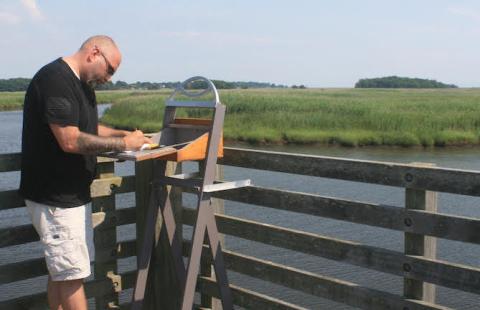What were the specific goals of this creative economy project? Describe the community development challenge or opportunity that your project was designed to address:
1. To celebrate how the arts cultivate our appreciation of beauty and wonder in the natural world around us and how its impact goes beyond making beautiful objects. Old Lyme provided an excellent case study of how artists in the community made the community aware of preserving the beauty that the artists found there.
2. The Arts can help us see the beauty and diversity of the natural world. If we appreciate something we begin to care for it and this leads to stewardship.
3. Using the arts as a tool to enhance our understanding of the world around us, and as a means of engaging more actively and profoundly with our local landscape.
Who was involved in this project and what did they do? (be sure to include the partners from outside of the creative sector and how local voices were included):
1.Artist/ coordinator: Ana Flores- responsible for design and coordinating the project with the partners
2.Land trusts: Old Lyme land trust, Old Lyme Open Space, - they each granted permission to use their sites and also were wardens for the boxes.
3. Other partners: Lyme Art Association, Conn. Dept of Energy and the Environment, they each gave permission to use their sites and also were wardens for the boxes
4. Students from Lyme Art Academy helped with installation of the boxes
5. General Public interacted with the boxes by going for walks and responding in the journals
How does this project relate to a larger community development strategy?
The project celebrated the importance of open space and the means by which those places have come to be protected. The Vision Boxes reminded people that beauty in the natural world is a solace and irreplaceable- and that artists and writers are often the first
to bring that to public awareness.
The project was also an example of how ecological art and design can illuminate narratives we might otherwise overlook or not be aware of.
The public engagement in the project also promoted health and wellness by encouraging families and individuals to take a walk, and to reflect and respond in the journals. Numerous people told me they had planned a special day to take a walk with their families to see the boxes.
What projects or places, if any, inspired your approach to this creative economy project?
Much of the land and townscape of Old Lyme felt like a 19th century painting. It made me curious to find out whether the fact that the town was known as an art colony where American Impressionism began affected the look of the area 100 years afterward. By investigating this I discovered the links between the art history and the conservation history in town.
My design for “Vision Boxes” is an evolution from another project that I have done over the years called “Poetry of the Wild” which combines working collaboratively with communities to do creative placemarking . The place markers are “poetry boxes: made by local artists, citizens and students which feature poems by local writers and poets . The poetry boxes are installed to make walking trails and each box has a journal for public comments.
Old Lyme’s history of land conservation added a new and interesting layer of seeing how the history of artists in the area and land conservation had braided together. The first example of this kind of connection in this country happened with the Hudson River School Painters. Their work recording the sublime wild places of this new country and helped create an American identity. Their paintings also inspired policy makers to conserve large tracts of land in New York state and out in the West. The first concept of a national park came from the artist George Catlin, a painter who painted the Native people in the West in the mid 1800’s. Catlin was witness to how quickly the land was changing and the demise of the tribes.
